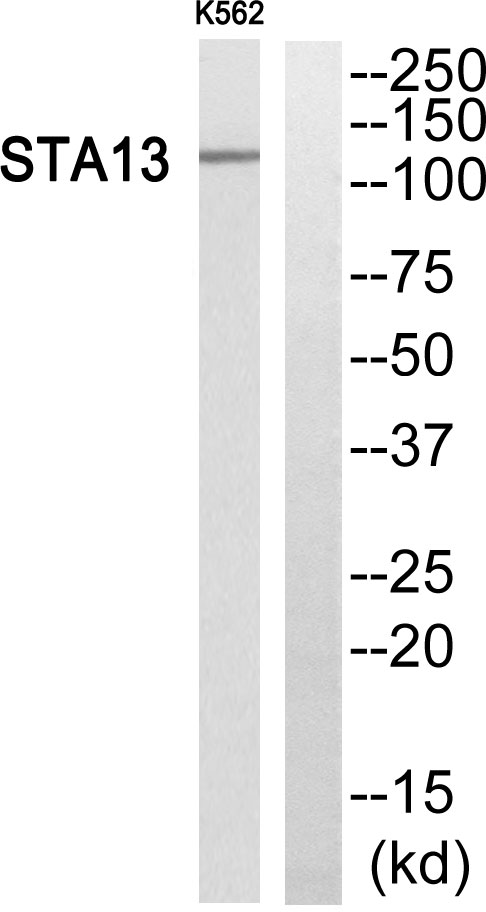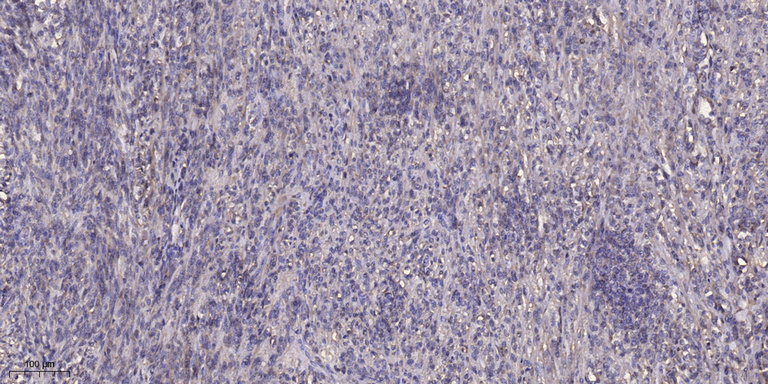StARD13 Polyclonal Antibody
- Catalog No.:YT4438
- Applications:WB;ELISA;IHC
- Reactivity:Human;Mouse
- Target:
- StARD13
- Gene Name:
- STARD13
- Protein Name:
- StAR-related lipid transfer protein 13
- Human Gene Id:
- 90627
- Human Swiss Prot No:
- Q9Y3M8
- Mouse Gene Id:
- 243362
- Mouse Swiss Prot No:
- Q923Q2
- Immunogen:
- The antiserum was produced against synthesized peptide derived from human STA13. AA range:101-150
- Specificity:
- StARD13 Polyclonal Antibody detects endogenous levels of StARD13 protein.
- Formulation:
- Liquid in PBS containing 50% glycerol, 0.5% BSA and 0.02% sodium azide.
- Source:
- Polyclonal, Rabbit,IgG
- Dilution:
- WB 1:500-2000;IHC 1:50-300; ELISA 2000-20000
- Purification:
- The antibody was affinity-purified from rabbit antiserum by affinity-chromatography using epitope-specific immunogen.
- Concentration:
- 1 mg/ml
- Storage Stability:
- -15°C to -25°C/1 year(Do not lower than -25°C)
- Other Name:
- STARD13;DLC2;GT650;StAR-related lipid transfer protein 13;46H23.2;Deleted in liver cancer 2 protein;DLC-2;Rho GTPase-activating protein;START domain-containing protein 13;StARD13
- Observed Band(KD):
- 125kD
- Background:
- This gene encodes a protein which contains an N-terminal sterile alpha motif (SAM) for protein-protein interactions, followed by an ATP/GTP-binding motif, a GTPase-activating protein (GAP) domain, and a C-terminal STAR-related lipid transfer (START) domain. It may be involved in regulation of cytoskeletal reorganization, cell proliferation, and cell motility, and acts as a tumor suppressor in hepatoma cells. The gene is located in a region of chromosome 13 that is associated with loss of heterozygosity in hepatocellular carcinomas. Alternatively spliced transcript variants encoding different isoforms have been described for this gene. [provided by RefSeq, Aug 2011],
- Function:
- function:GTPase-activating protein for RhoA, and perhaps for Cdc42. May be involved in regulation of cytoskeletal reorganization, cell proliferation and cell motility. Acts a tumor suppressor in hepatocellular carcinoma cells.,similarity:Contains 1 Rho-GAP domain.,similarity:Contains 1 SAM (sterile alpha motif) domain.,similarity:Contains 1 START domain.,subunit:Homodimer. Interacts with TAX1BP1.,tissue specificity:Ubiquitously expressed. Underexpressed in hepatocellular carcinoma cells and some breast cancer cell lines.,
- Subcellular Location:
- Cytoplasm. Membrane; Peripheral membrane protein; Cytoplasmic side. Mitochondrion membrane; Peripheral membrane protein; Cytoplasmic side. Lipid droplet.
- Expression:
- Ubiquitously expressed. Underexpressed in hepatocellular carcinoma cells and some breast cancer cell lines.
- June 19-2018
- WESTERN IMMUNOBLOTTING PROTOCOL
- June 19-2018
- IMMUNOHISTOCHEMISTRY-PARAFFIN PROTOCOL
- June 19-2018
- IMMUNOFLUORESCENCE PROTOCOL
- September 08-2020
- FLOW-CYTOMEYRT-PROTOCOL
- May 20-2022
- Cell-Based ELISA│解您多样本WB检测之困扰
- July 13-2018
- CELL-BASED-ELISA-PROTOCOL-FOR-ACETYL-PROTEIN
- July 13-2018
- CELL-BASED-ELISA-PROTOCOL-FOR-PHOSPHO-PROTEIN
- July 13-2018
- Antibody-FAQs
- Products Images

- Western blot analysis of STA13 Antibody. The lane on the right is blocked with the STA13 peptide.

- Immunofluorescence analysis of A549 cells, using STA13 Antibody. The picture on the right is blocked with the synthesized peptide.

- Immunohistochemical analysis of paraffin-embedded human Colon cancer. 1, Antibody was diluted at 1:200(4° overnight). 2, Tris-EDTA,pH9.0 was used for antigen retrieval. 3,Secondary antibody was diluted at 1:200(room temperature, 45min).



